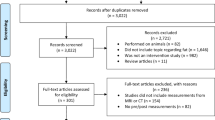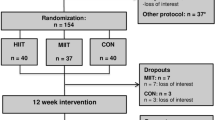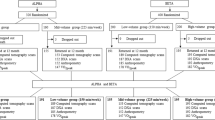Abstract
OBJECTIVE:
To test the effects on abdominal fat reduction of adding aerobic exercise training to a diet program and obesity phenotype in response to weight loss.
DESIGN:
A prospective clinical trial with a 14-week weight-loss intervention design.
SETTING AND PARTICIPANTS:
In total, 209 overweight and obese women were assigned to four subgroups depending on type of treatment and the subject's obesity phenotype: diet alone (DA) with intra-abdominal fat (IF) obesity (≥mean IF area), diet plus exercise (DE) with IF obesity, DA with abdominal subcutaneous fat (ASF) obesity (<mean IF area) and DE with ASF obesity. Abdominal fat areas were evaluated by CT scans, with values adjusted for selected variables.
RESULTS:
Values were adjusted for age, menopausal status and change in body weight and total fat mass. The IF reductions were significantly (P<0.0001) greater in subjects with IF obesity phenotype (−45.1 cm2) compared to the ASF obesity phenotype (−22.2 cm2). The ASF reductions were significantly (P<0.001) greater for subjects with ASF obesity (−74.5 cm2) compared to IF obesity (−55.5 cm2). For IF obesity, the IF reduction was significantly (P<0.01) greater in the DE group (−49.3 cm2) than in the DA group (−37.8 cm2).
CONCLUSION:
These results suggest that for individuals with IF obesity, the efficacy on reducing IF of adding aerobic exercise training to a diet-alone weight-reduction program is more prominent (−49.3 cm2/−37.8 cm2=1.3 times) compared with DA. Moreover, abdominal fat reduction was found to be modified by obesity phenotype in response to weight loss.
This is a preview of subscription content, access via your institution
Access options
Subscribe to this journal
Receive 12 print issues and online access
$259.00 per year
only $21.58 per issue
Buy this article
- Purchase on Springer Link
- Instant access to full article PDF
Prices may be subject to local taxes which are calculated during checkout




Similar content being viewed by others
References
Kenchaiah S, Evans JC, Levy D, Wilson PW, Benjamin EJ, Larson MG, Kannel WB, Vasan RS . Obesity and the risk of heart failure. N Engl J Med 2002; 347: 305–313.
Rexrode KM, Hennekens CH, Willett WC, Colditz GA, Stampfer MJ, Rich-Edwards JW, Speizer FE, Manson JE . A prospective study of body mass index, weight change, and risk of stroke in women. JAMA 1997; 277: 1539–1545.
Mokdad AH, Ford ES, Bowman BA, Dietz WH, Vinicor F, Bales VS, Marks JS . Prevalence of obesity, diabetes, and obesity-related health risk factors, 2001. JAMA 2003; 289: 76–79.
Vague J . The degree of masculine differentiation of obesities. Am J Clin Nutri 1956; 4: 20–34.
Gillum RF, Mussolino ME, Madans JH . Body fat distribution and hypertension incidence in women and men. The NHANES I Epidemiologic Follow-up Study. Int J Obes Relat Metab Disord 1998; 22: 127–134.
Rexrode KM, Carey VJ, Hennekens CH, Walters EE, Colditz GA, Stampfer MJ, Willett WC, Manson JE . Abdominal adiposity and coronary heart disease in women. JAMA 1998; 280: 1843–1848.
Kanai H, Matsuzawa Y, Kotani K, Keno Y, Kobatake T, Nagai Y, Fujioka S, Tokunaga K, Tarui S . Close correlation of intra-abdominal fat accumulation to hypertension in obese women. Hypertension 1990; 16: 484–490.
Matsuzawa Y, Nakamura T, Shimomura I, Kotani K . Visceral fat accumulation and cardiovascular disease. Obes Res 1995; 5 (Suppl 3): 645S–647S.
Macor C, Ruggeri A, Mazzonetto P, Federspil G, Cobelli C, Vettor R . Visceral adipose tissue impairs insulin secretion and insulin sensitivity but not energy expenditure in obesity. Metabolism 1997; 46: 123–129.
Rippe JM . The case for medical management of obesity: a call for increased physician involvement. Obes Res 1998; 1 (Suppl 6): 23S–33S.
Wirth A, Steinmetz B . Gender differences in changes in subcutaneous and intra-abdominal fat during weight reduction: an ultrasound study. Obes Res 1998; 6: 393–399.
Janssen I, Ross R . Effects of sex on the change in visceral, subcutaneous adipose tissue and skeletal muscle in response to weight loss. Int J Obes Relat Metab Disord 1999; 23: 1035–1046.
van Aggel-Leijssen DP, Saris WH, Hul GB, van Baak MA . Short-term effects of weight loss with or without low-intensity exercise training on fat metabolism in obese men. Am J Clin Nutr 2001; 73: 523–531.
Jakicic JM, Clark K, Coleman E, Donnelly JE, Foreyt J, Melanson E, Volek J, Volpe SL . American College of Sports Medicine position stand. Appropriate intervention strategies for weight loss and prevention of weight regain for adults. Med Sci Sports Exerc 2001; 33: 2145–2156.
Ross R, Janssen I . Is abdominal fat preferentially reduced in response to exercise-induced weight loss? Med Sci Sports Exerc 1999; 31 (Suppl 11): S568–S572.
Ross R, Janssen I . Physical activity, total and regional obesity: dose-response considerations. Med Sci Sports Exerc 2001; 33 (Suppl 6): S521–S527.
Westerterp KR . Obesity and physical activity. Int J Obes Relat Metab Disord 1999; 23 (Suppl 1): 59S–64S.
Donnelly JE, Jacobsen DJ, Heelan KS, Seip R, Smith S . The effects of 18 months of intermittent vs continuous exercise on aerobic capacity, body weight and composition, and metabolic fitness in previously sedentary, moderately obese females. Int J Obes Relat Metab Disord 2000; 24: 566–572.
Mertens DJ, Kavanagh T, Campbell RB, Shephard RJ . Exercise without dietary restriction as a means to long-term fat loss in the obese cardiac patient. J Sports Med Phys Fitness 1998; 38: 310–316.
Mourier A, Gautier JF, De Kerviler E, Bigard AX, Villette JM, Garnier JP, Duvallet A, Guezennec CY, Cathelineau G . Mobilization of visceral adipose tissue related to the improvement in insulin sensitivity in response to physical training in NIDDM. Effects of branched-chain amino acid supplements. Diabetes Care 1997; 20: 385–391.
Ross R, Dagnone D, Jones PJ, Smith H, Paddags A, Hudson R, Janssen I . Reduction in obesity and related comorbid conditions after diet-induced weight loss or exercise-induced weight loss in men. A randomized, controlled trial. Ann Intern Med 2000; 133: 92–103.
Schwartz RS, Shuman WP, Larson V, Cain KC, Fellingham GW, Beard JC, Kahn SE, Stratton JR, Cerqueira MD, Abrass IB . The effect of intensive endurance exercise training on body fat distribution in young and older men. Metabolism 1991; 40: 545–551.
Bouchard C, Tremblay A, Despres JP, Theriault G, Nadeau A, Lupien PJ, Moorjani S, Prudhomme D, Fournier G . The response to exercise with constant energy intake in identical twins. Obes Res 1994; 2: 400–410.
DiPietro L, Seeman TE, Stachenfeld NS, Katz LD, Nadel ER . Moderate-intensity aerobic training improves glucose tolerance in aging independent of abdominal adiposity. J Am Geriatr Soc 1998; 46: 875–879.
Despres JP, Pouliot MC, Moorjani S, Nadeau A, Tremblay A, Lupien PJ, Theriault G, Bouchard C . Loss of abdominal fat and metabolic response to exercise training in obese women. Am J Physiol 1991; 261: E159–E167.
National Institutes of Health; National Heart, Lung, and Blood Institute. Clinical guidelines on the identification, evaluation, and treatment of overweight and obesity in adults: the evidence report. Obes Res 1998; 6 (Suppl 2): 51S–209S.
Shimomura I, Tokunaga K, Kotani K, Keno Y, Yanase-Fujiwara M, Kanosue K, Jiao S, Funahashi T, Kobatake T, Yamamoto T . Marked reduction of acyl-CoA synthetase activity and mRNA in intra-abdominal visceral fat by physical exercise. Am J Physiol 1993; 265: E44–E50.
The Examination Committee of Criteria for ‘Obesity Disease’ in Japan, Japan Society for the Study of Obesity. New criteria for ‘obesity disease’ in Japan. Circ J 2002; 66: 987–992.
Tanaka K, Nakadomo F, Watanabe K, Inagaki A, Kim HK, Matsuura Y . Body composition prediction equations based on bioelectrical impedance and anthropometric variables for Japanese obese women. Am J Hum Biol 1992; 4: 739–745.
Yoshizumi T, Nakamura T, Yamane M, Islam AH, Menju M, Yamasaki K, Arai T, Kotani K, Funahashi T, Yamashita S, Matsuzawa Y . Abdominal fat: standardized technique for measurement at CT. Radiology 1999; 211: 283–286.
Olson MS, Williford HN, Blessing DL, Greathouse R . The cardiovascular and metabolic effects of bench stepping exercise in females. Med Sci Sports Exerc 1991; 23: 1311–1317.
Borg G . Perceived exertion: a note on ‘history’ and methods. Med Sci Sports 1973; 5: 90–93.
American College of Sports Medicine. ACSM's guidelines for exercise testing and prescription, 6th edn. Williams & Wilkins: Philadelphia, PA; 2000. pp 153.
Irwin ML, Yasui Y, Ulrich CM, Bowen D, Rudolph RE, Schwartz RS, Yukawa M, Aiello E, Potter JD, McTiernan A . Effect of exercise on total and intra-abdominal body fat in postmenopausal women: a randomized controlled trial. JAMA 2003; 289: 323–330.
Riechman SE, Schoen RE, Weissfeld JL, Thaete FL, Kriska AM . Association of physical activity and visceral adipose tissue in older women and men. Obes Res 2002; 10: 1065–1073.
Acknowledgements
This work was supported in part by Grants-in-Aid from the Japanese Society of Physical Fitness and Sports Medicine (1998–2000), by the TanakaProject (2004–2006) of TARA (Tsukuba Advanced Research Alliance) at University of Tsukuba, and by the 21st century COE (Center of Excellence) program, Ministry of Education, Culture, Sports, Science and Technology (2002–2006 Nishihira Project: Promotion of health and sport scientific research).
Author information
Authors and Affiliations
Corresponding author
Rights and permissions
About this article
Cite this article
Okura, T., Nakata, Y., Lee, D. et al. Effects of aerobic exercise and obesity phenotype on abdominal fat reduction in response to weight loss. Int J Obes 29, 1259–1266 (2005). https://doi.org/10.1038/sj.ijo.0803013
Received:
Revised:
Accepted:
Published:
Issue Date:
DOI: https://doi.org/10.1038/sj.ijo.0803013
Keywords
This article is cited by
-
A new approach to quantify visceral fat via bioelectrical impedance analysis and ultrasound compared to MRI
International Journal of Obesity (2024)
-
Comparisons of calorie restriction and structured exercise on reductions in visceral and abdominal subcutaneous adipose tissue: a systematic review
European Journal of Clinical Nutrition (2022)
-
Experimental evaluation of high intensity focused ultrasound for fat reduction of ex vivo porcine adipose tissue
Journal of Ultrasound (2022)
-
Subcutaneous fat loss is greater than visceral fat loss with diet and exercise, weight-loss promoting drugs and bariatric surgery: a critical review and meta-analysis
International Journal of Obesity (2017)
-
Impact des ultrasons diffus combinés au travail musculaire sur plaque vibrante sur la modification de la composition corporelle de femmes modérément obèses
Obésité (2014)



